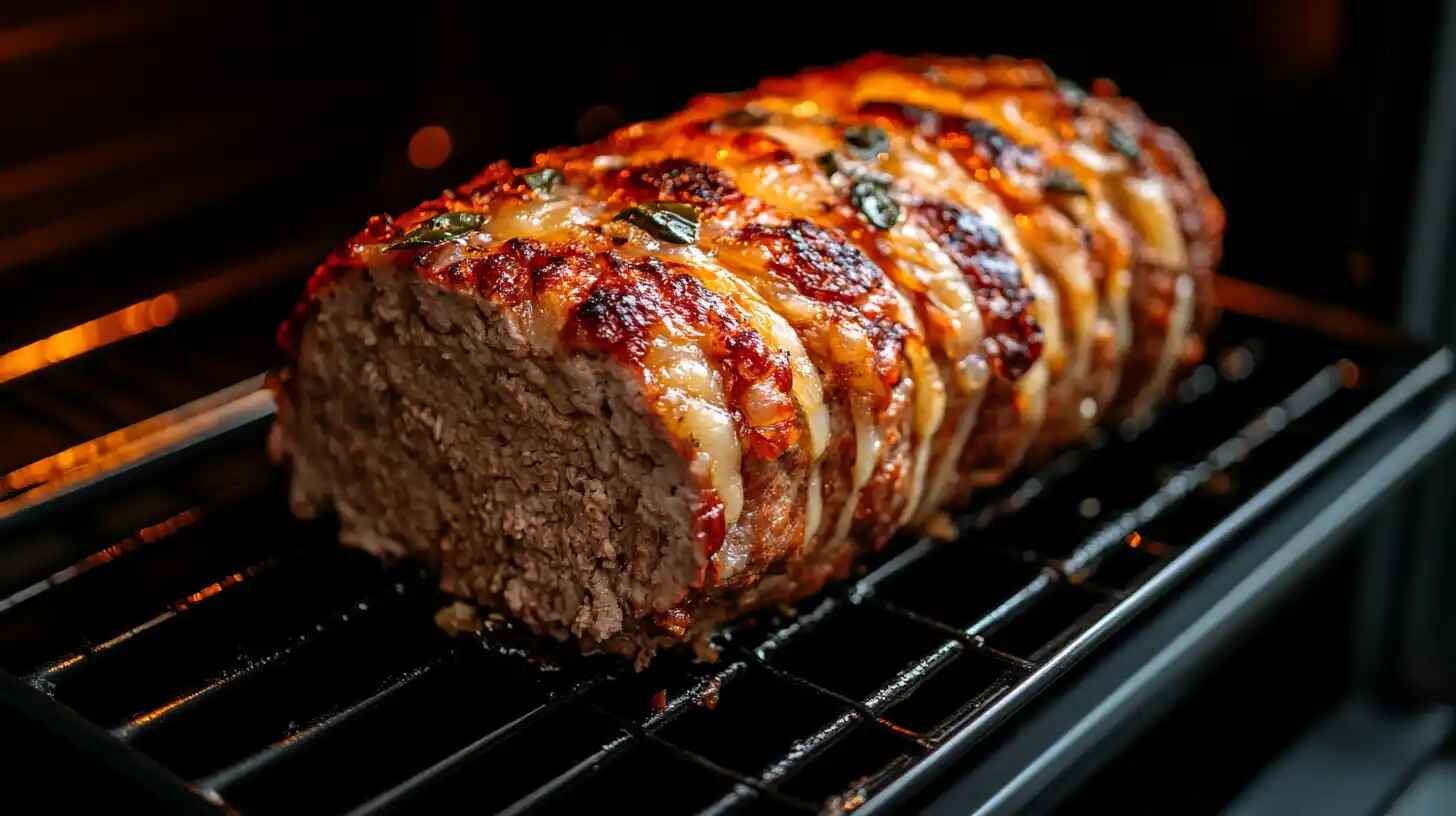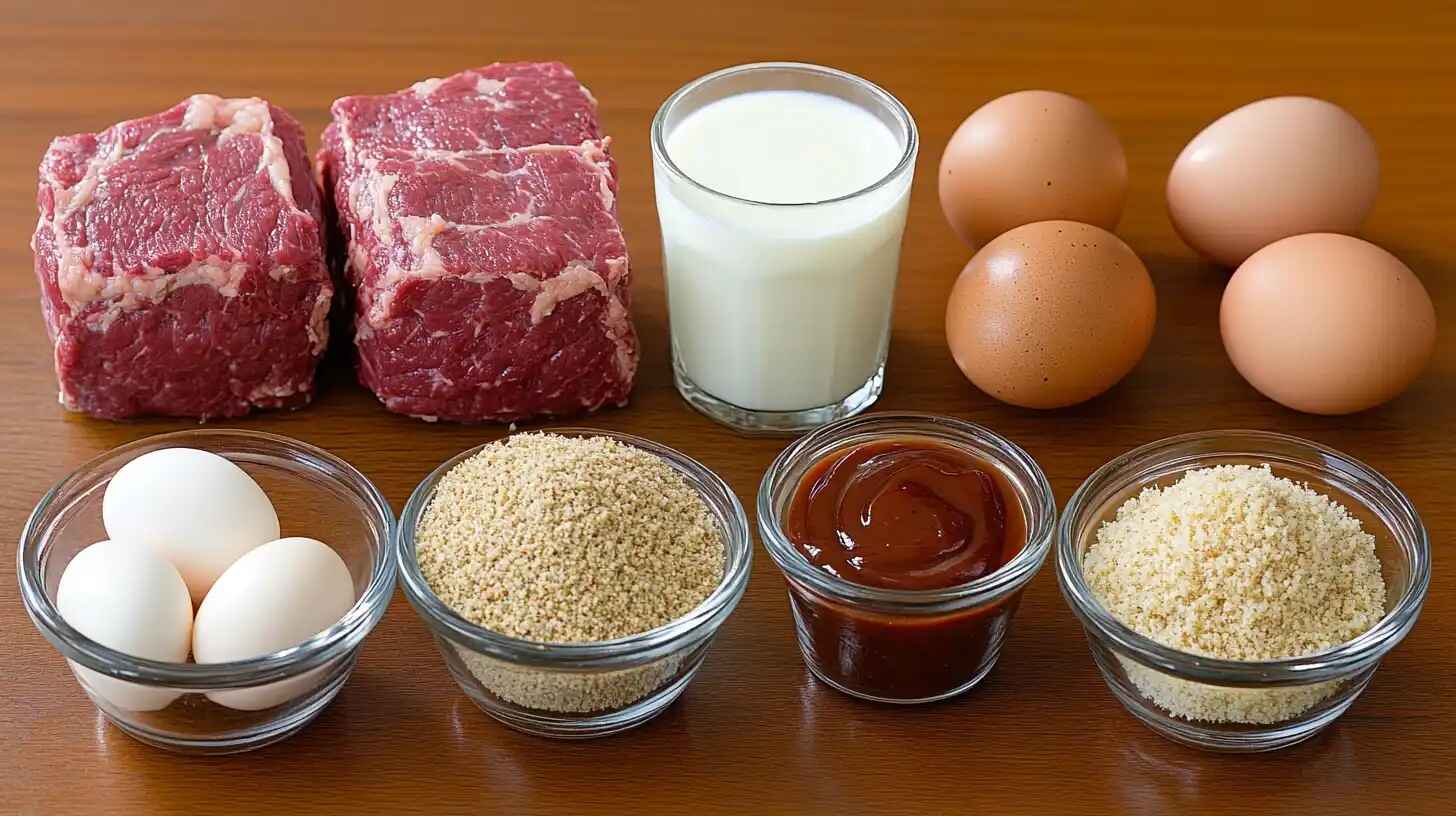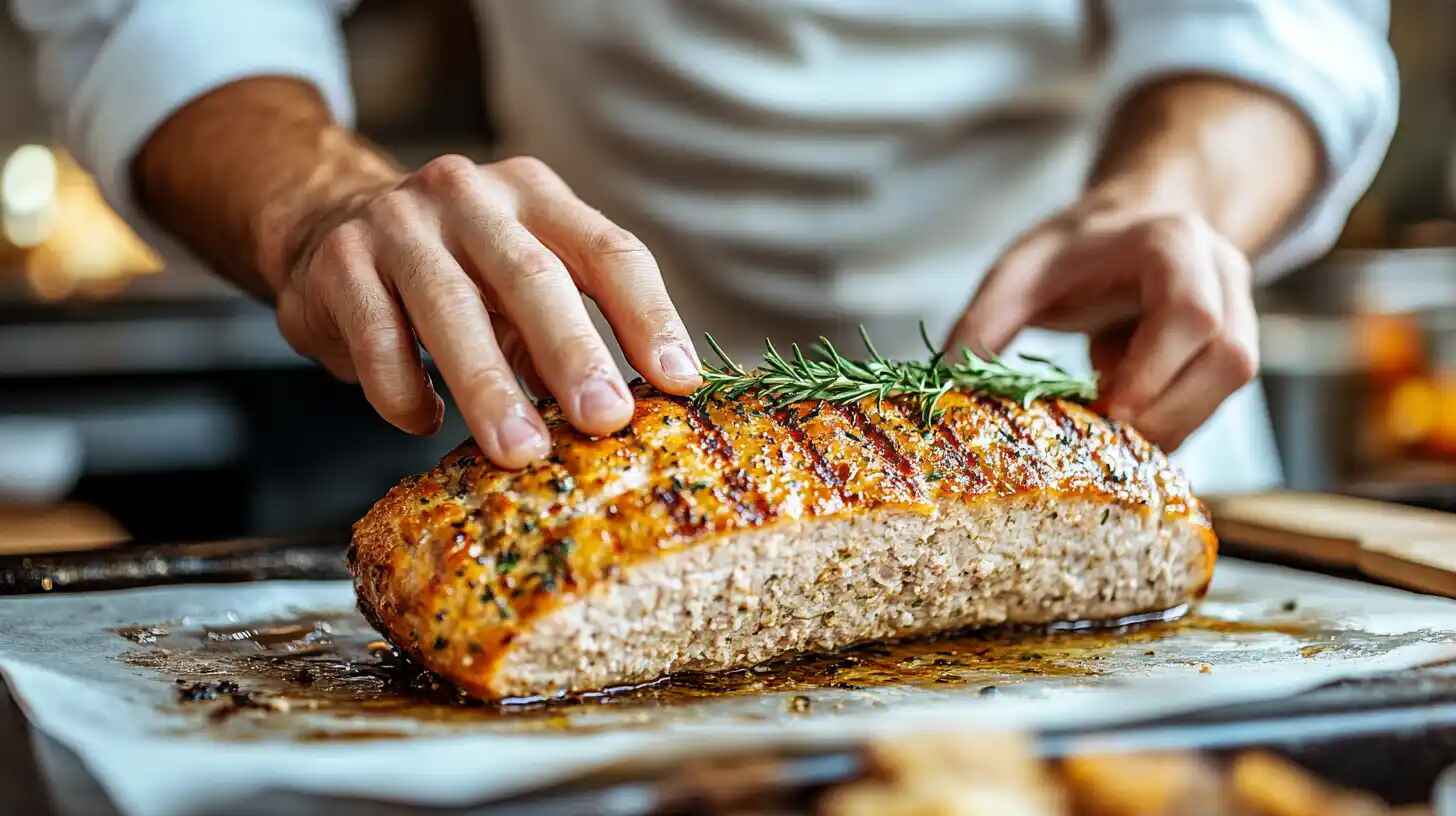So you’ve cooked up what smells like the perfect meatloaf. The outside is browned just right, your kitchen smells amazing, and everyone’s ready to dig in. But then—surprise! You slice into the center and… it’s still pink inside. Now you’re stuck wondering: “Is this safe to eat or should I throw it back in the oven?”
If this situation sounds familiar, don’t worry—you’re definitely not alone. A pink middle in a cooked meatloaf confuses a lot of home cooks. You might think pink means raw, but it’s not always that simple. In this article, we’ll unpack why your meatloaf might still be pink, when that’s okay, and what to do if it’s not.
“Don’t judge meatloaf by its color—judge it by its temperature.”
Table of Contents
Let’s break down the science behind meat color, explore common cooking issues, and help you become a meatloaf master!

Understanding the Problem: Why Is My Meatloaf Still Pink Inside?
The Science Behind Meat Color
Let’s start with some basic food science. When meat cooks, we usually expect it to turn from red or pink to brown or gray. That change happens because of a protein called myoglobin, which stores oxygen in muscle tissue. When myoglobin gets heated, it usually turns brown.
But here’s the kicker: certain conditions—like pH levels, the presence of gases, or even other ingredients—can keep that pink color locked in, even if your meat is fully cooked.
Myoglobin and Cooking Reactions
When meat is heated, myoglobin denatures (breaks down), which usually leads to a color change. But sometimes, chemical reactions between the meat and other ingredients like onions, garlic, or acidic sauces can stabilize the pink color. That means your meatloaf might look undercooked even when it’s perfectly safe to eat.
Internal Temperature vs. Color
This is the golden rule: Color is not a reliable indicator of doneness. The only way to know for sure if your meatloaf is safe is by checking its internal temperature.
According to the USDA, ground beef should be cooked to an internal temperature of 160°F (71°C).
That’s it. If your thermometer reads 160°F, your meatloaf is done—even if it’s still pink.
Common Causes of Pink Meatloaf After Cooking
Undercooking or Inaccurate Cooking Times
Let’s be honest—sometimes we’re just in a rush. If you don’t cook your meatloaf long enough, of course it’s going to be pink (and unsafe). But even if you follow a recipe exactly, your oven might run a little cool or heat unevenly. That’s why a meat thermometer is your best friend.
Type of Meat Used
Did you use beef? Turkey? A mix of pork and veal? Different meats react differently when cooked. Turkey and pork, for example, often stay pink longer—even when fully cooked. This is especially true for ground meats mixed together, which can create different chemical reactions in the oven.
Use of Curing Agents or Additives
Ever added bacon, smoked salt, or seasoned breadcrumbs to your mix? These ingredients can contain nitrates or nitrites—similar to what you find in cured meats like ham. They can literally “fix” the pink color in the meat, making it stay pink even after reaching safe temperatures.
Smoking and Cooking Methods
If you’ve ever smoked a meatloaf or added smoke flavoring, it might explain the persistent pink. Smoking creates nitrogen dioxide, which binds with the meat and causes a pink “smoke ring.” That’s why your meatloaf can be fully cooked and still have a pink center.
Oven Temperature Fluctuations
Not all ovens are created equal. Some run hotter or cooler than the setting you dial in. If your oven’s internal temperature fluctuates, you might think your meatloaf is done when it’s not—or vice versa. Investing in an oven thermometer can really help here.
Is Pink Meatloaf Dangerous? Food Safety Explained
USDA Guidelines on Ground Meat Safety
Let’s look at what the pros say. The USDA recommends that all ground meat dishes (including meatloaf) be cooked to a minimum internal temperature of 160°F. This is because grinding meat exposes more surface area to bacteria, which means it needs thorough cooking to kill off anything harmful like E. coli or Salmonella.
Temperature vs. Visual Cues
If you remember one thing from this article, let it be this:
“Always trust a meat thermometer. Never trust color alone.”
Even if your meatloaf looks brown throughout, it could be undercooked if it hasn’t reached 160°F. Conversely, a pink meatloaf can be totally safe if it has hit that temperature.
Risks of Consuming Undercooked Ground Meat
Now, just because something looks cooked doesn’t mean it is. Eating undercooked ground meat can lead to foodborne illness—nausea, diarrhea, vomiting, and worse. That’s not something you want to risk for the sake of saving a few minutes or going by looks alone.
How to Tell If Your Meatloaf Is Fully Cooked
The Only Reliable Tool: Meat Thermometer
If you’re cooking meatloaf without a thermometer, you’re basically guessing. A simple instant-read thermometer is cheap, easy to use, and will save you from overcooked edges and undercooked centers.
Ideal Internal Temperatures by Meat Type
| Meat Type | Safe Internal Temp (°F) |
|---|---|
| Ground Beef | 160°F |
| Ground Turkey | 165°F |
| Ground Pork | 160°F |
| Mixed Meat (e.g. Beef & Veal) | 160°F |
Resting Time and Carryover Cooking
Here’s a cool trick—your meatloaf keeps cooking even after you take it out of the oven. This is called “carryover cooking,” and it can raise the internal temp by another 5°F. So, if your thermometer reads 155°F, let it rest for 5–10 minutes covered in foil. It should reach a safe temp naturally.
Most Common Myths About Pink Meatloaf
Myth 1: Pink Always Means Undercooked
We’ve already busted this one. Pink meat doesn’t always mean raw meat. Chemical reactions, meat types, and even your cooking method can all affect the color—but not the safety.
Myth 2: Longer Cooking Time Always Solves It
Overcooking won’t necessarily “fix” the color. You might just end up with dry, tough meatloaf that still looks pink. The key is temperature, not time.
Myth 3: Color Change Is Instant After Proper Cooking
Sometimes, meat needs a few minutes of rest to finish its transformation. Also, if the meat has additives or special seasonings, it may never fully change color—and that’s okay.
Nutrition Facts (Per Serving)
| Nutrient | Amount (Approx.) |
|---|---|
| Calories | 270 |
| Protein | 22g |
| Fat | 18g |
| Carbohydrates | 10g |
| Sodium | 480mg |

Ingredients List (Classic Meatloaf)
| Ingredient | Quantity |
|---|---|
| Ground beef (85% lean) | 1.5 lbs |
| Breadcrumbs | 1 cup |
| Milk | 1/2 cup |
| Egg | 1 large |
| Onion (finely chopped) | 1 small |
| Ketchup | 1/4 cup |
| Salt | 1 tsp |
| Black Pepper | 1/2 tsp |
Tips to Prevent Pink Meatloaf (If It Bothers You)
If the sight of pink meatloaf still makes you nervous—or grosses out your dinner guests—don’t worry. There are a few smart steps you can take to reduce that pink color while still keeping your meatloaf juicy and flavorful.
Choosing the Right Meat Blend
Some meat blends are more likely to stay pink. If you’re using a lot of pork or turkey, those meats tend to keep that pink hue even when cooked. Instead, try sticking with 80/20 or 85/15 ground beef. It’s less likely to look pink and also adds great flavor and moisture.
Proper Mixing Techniques
Overmixing your meatloaf can actually mess with its texture and color. You don’t want to beat the meat to death—just mix until combined. Gentle mixing helps keep the proteins from breaking down too much, which can affect how the meat reacts to heat and may even cause uneven color.
Cooking at the Correct Oven Temperature
It might be tempting to crank your oven up to 400°F to cook it faster, but slower is better. Try baking your meatloaf at around 350°F (175°C). It helps the inside cook more evenly and gives the exterior a nice golden brown crust without drying it out.
Allowing for Rest Time After Cooking
Once you take it out of the oven, let your meatloaf rest for 10–15 minutes. This gives the juices time to redistribute and allows the internal temperature to rise a bit more. Bonus: the color may deepen during this time too.
Best Meat Thermometers for Home Cooks
If you don’t have a meat thermometer, it’s time to get one. Seriously—it’s a game changer. Here are your two main options:
Digital vs. Analog Thermometers
- Digital Instant-Read: Super fast and easy to use. Just stick it into the center and get a reading in seconds.
- Analog (Dial-Type): Slower, and sometimes harder to read. But they’re cheaper and don’t need batteries.
Features to Look For
- Backlit Display: For low-light kitchens.
- Waterproof Design: Easy cleanup.
- Auto Shut-Off: Saves battery life.
For best results, insert the thermometer into the thickest part of the meatloaf—right in the center. Avoid touching the pan or you’ll get a false reading.
Professional Chef Tips for the Perfect Meatloaf
Moisture Retention Without Compromising Doneness
Want a moist meatloaf that’s also fully cooked? Use a mix of wet and dry ingredients. Think eggs, milk, onions, and ketchup (wet) + breadcrumbs or crushed crackers (dry). These act as binders and help retain moisture during cooking.
Layering Flavors and Preventing Dryness
Don’t forget the seasonings! A bland meatloaf is a sad meatloaf. Try adding Worcestershire sauce, garlic powder, thyme, or a touch of mustard for bold, savory flavor. And for even more moisture? Add a bit of grated zucchini or carrot to your mix. Sneaky and delicious!
When to Worry: Signs Your Meatloaf Is Unsafe
Okay, so you’re not just dealing with color anymore. Maybe your meatloaf smells off or has a weird texture. Here are some red flags that should NOT be ignored:
Texture, Smell, and Juice Color Indicators
- Smell: If it smells sour, sulfuric, or just “off,” toss it. Trust your nose.
- Texture: Mushy meatloaf can be a sign of undercooked ingredients. It should be firm but tender.
- Juice: Clear or light pink juices are usually fine, but if the juices are bright red and runny, it’s not done.
Handling and Storage Tips Before Cooking
How you store and prep your meat matters just as much as how you cook it. Always:
- Keep meat refrigerated below 40°F (4°C)
- Use it within 1–2 days of purchase
- Wash hands and tools thoroughly after handling raw meat
Frequently Asked Questions (FAQs)
Can You Eat Slightly Pink Meatloaf?
Yes—as long as the internal temperature reaches 160°F. Color alone doesn’t tell the whole story. Use a thermometer to be sure.
Why Is My Turkey Meatloaf Pink?
Turkey often stays pink even when it’s well-cooked. It’s especially common if you’ve added ingredients like onions, garlic, or lemon juice, which interact with proteins and keep that pink shade.
Can I Reheat Pink Meatloaf to Make It Safer?
If your meatloaf is pink and wasn’t fully cooked the first time, yes—reheat it to at least 160°F internally. But if it was already safely cooked, reheating won’t make a difference to the color.
Should I Cook Meatloaf Covered or Uncovered?
Both methods work, but here’s a general rule:
- Covered: Keeps it moist during baking. Great for dense meatloafs.
- Uncovered: Allows for a crusty top and better browning. Remove cover in the last 15–20 minutes for a nice glaze.

Last Bite
Here’s the big takeaway: If your meatloaf is still pink inside, that doesn’t automatically mean it’s raw or unsafe. Color is influenced by a bunch of factors—from ingredients to cooking method to the type of meat used. The only real way to know if it’s safe is to check the temperature.
160°F is the magic number. Get yourself a meat thermometer and never second-guess dinner again.
So next time your meatloaf throws you a curveball with a pink center, don’t panic. You’ve got the knowledge, the tools, and the confidence to serve it up like a pro. No more guessing, no more dry meatloaf, just delicious, juicy, safe comfort food.
Looking for the perfect dessert to follow your hearty meatloaf dinner? Try Carrot Cake Cheesecake Bites! These little treats combine the cozy spice of carrot cake with the creamy richness of cheesecake—all in a bite-sized delight. They’re light, flavorful, and just sweet enough to end your meal on a high note without feeling too heavy. Plus, they’re easy to make ahead and always a crowd-pleaser!

